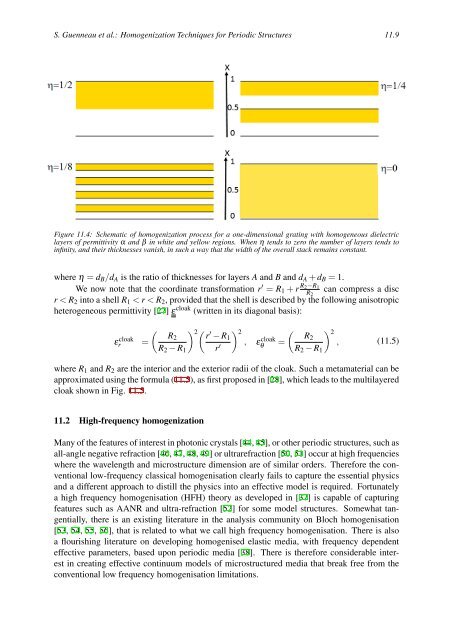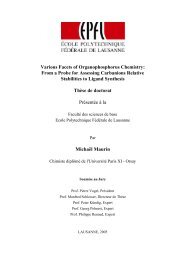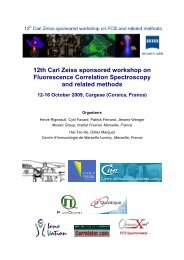GratinGs: theory and numeric applications - Institut Fresnel
GratinGs: theory and numeric applications - Institut Fresnel
GratinGs: theory and numeric applications - Institut Fresnel
You also want an ePaper? Increase the reach of your titles
YUMPU automatically turns print PDFs into web optimized ePapers that Google loves.
S. Guenneau et al.: Homogenization Techniques for Periodic Structures 11.9<br />
Figure 11.4: Schematic of homogenization process for a one-dimensional grating with homogeneous dielectric<br />
layers of permittivity α <strong>and</strong> β in white <strong>and</strong> yellow regions. When η tends to zero the number of layers tends to<br />
infinity, <strong>and</strong> their thicknesses vanish, in such a way that the width of the overall stack remains constant.<br />
where η = dB/dA is the ratio of thicknesses for layers A <strong>and</strong> B <strong>and</strong> dA + dB = 1.<br />
We now note that the coordinate transformation r ′ = R1 + r R2−R1 can compress a disc<br />
R2<br />
r < R2 into a shell R1 < r < R2, provided that the shell is described by the following anisotropic<br />
heterogeneous permittivity [27] ε cloak (written in its diagonal basis):<br />
ε cloak<br />
r<br />
=<br />
( R2<br />
R2 − R1<br />
) 2 (<br />
r ′ − R1<br />
r ′<br />
) 2<br />
, εcloak ( ) 2<br />
R2<br />
θ =<br />
,<br />
R2 − R1<br />
(11.5)<br />
where R1 <strong>and</strong> R2 are the interior <strong>and</strong> the exterior radii of the cloak. Such a metamaterial can be<br />
approximated using the formula (11.5), as first proposed in [28], which leads to the multilayered<br />
cloak shown in Fig. 11.5.<br />
11.2 High-frequency homogenization<br />
Many of the features of interest in photonic crystals [44, 45], or other periodic structures, such as<br />
all-angle negative refraction [46, 47, 48, 49] or ultrarefraction [50, 51] occur at high frequencies<br />
where the wavelength <strong>and</strong> microstructure dimension are of similar orders. Therefore the conventional<br />
low-frequency classical homogenisation clearly fails to capture the essential physics<br />
<strong>and</strong> a different approach to distill the physics into an effective model is required. Fortunately<br />
a high frequency homogenisation (HFH) <strong>theory</strong> as developed in [37] is capable of capturing<br />
features such as AANR <strong>and</strong> ultra-refraction [52] for some model structures. Somewhat tangentially,<br />
there is an existing literature in the analysis community on Bloch homogenisation<br />
[53, 54, 55, 56], that is related to what we call high frequency homogenisation. There is also<br />
a flourishing literature on developing homogenised elastic media, with frequency dependent<br />
effective parameters, based upon periodic media [38]. There is therefore considerable interest<br />
in creating effective continuum models of microstructured media that break free from the<br />
conventional low frequency homogenisation limitations.













